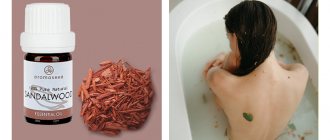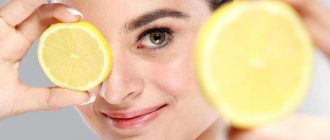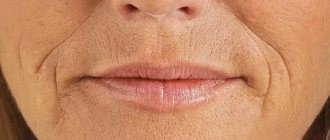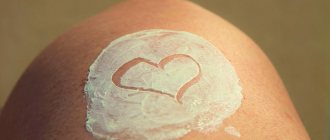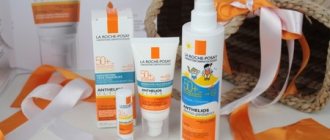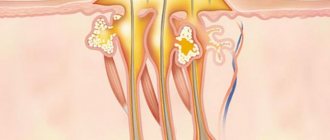About 30 years ago, the concept of “cosmetics for girls” simply did not exist. Pharmacies offered care products - baby cream, powder, toothpaste, shampoo. The makeup of young ladies was limited to hygienic lipstick with berry or fruit flavor. Today, a whole area of cosmetology is working on the creation of children's cosmetics - from wet wipes for newborns to universal makeup kits for teenagers. The task of parents is to choose safe cosmetics that are appropriate for the age of the child.
Children always strive to imitate their parents. When a girl grows up in a family, sooner or later she will get to her mother’s cosmetic bag to decorate herself. Women's makeup is unlikely to make a young fashionista more beautiful, but it can harm the health of the skin and mucous membranes. If a daughter copies her mother, then the girl should have her own makeup bag. Children can use cosmetics that are designed taking into account age-related skin characteristics. How to choose cosmetics wisely for a child, and at what age can they be used? Let's talk about this in our article.
General recommendations: why children need special cosmetics
Marketers in the beauty industry don’t “eat their own bread” for nothing. Children's cosmetics and hygiene products are distinguished by creative designs. Baby products feature smiling babies that attract young mothers. And the bright pink packaging with the image of Barbie or Princess Jasmine will appeal to a girl 4-7 years old.
For children's cosmetics, the main thing is not the appearance, but the content. A child's skin is more sensitive than that of an adult. The thin skin of a newborn consists of 3 layers instead of 5, and the connection between the top layer (epidermis) and the dermis is very fragile. In preschool and primary school age, due to the imperfection of the immune system, the skin is prone to allergic reactions. In children, the permeability of the epidermal barrier is increased, so the risk of skin damage and infection increases. Puberty is characterized by intense work of the sweat and sebaceous subcutaneous glands. Increased sweating and increased production of fatty secretions make a teenager's skin vulnerable to inflammation. In addition to the characteristics of the epidermis, the structure of the hair changes with age. Baby fluff and oily teenage locks require different hygienic care.
When choosing cosmetics, you need to take into account age nuances, personal contraindications, and pay attention to reviews from cosmetologists and pediatricians.
Children's face cream for adults: reviews
When planning to try a product for the first time, we want to know the opinions of those who have already experienced it for themselves. In fact, many women have tried using baby cream, and definitely almost all young mothers. Most criticism is directed at classic fatty formulations. A minimal percentage of respondents recommend it as a face cream for every day, but it is suitable for treating dryness and flaking. As for modern imported moisturizers, there are more good reviews. Many ladies admit: “I smear my face with baby cream almost every day and enjoy the results, but I’m embarrassed to talk about my beauty secret.” To be fair, it is worth noting that domestic brands delight babies and their mothers with a wide variety of cosmetics - from economy class to quite expensive products. Among such an assortment, you can try to find a product that is right for you. Having studied all the reviews of women who have tried baby cream on themselves, we can come to the conclusion that the results are either positive or simply absent. Cosmetics designed for babies really cannot harm or cause allergies.
What cosmetics does a child need?
Children's products include cosmetics from 0 to 14 years. According to their purpose, they are hygienic (caring), protective, medicinal, and decorative. How many goods does a child need? Parents decide until the child “grows” with his taste preferences. Modern hygiene products for babies and children's cosmetics can be divided into several categories.
Caring cosmetics include: • soap, shower gel, shampoo, toothpaste; • baby bathing products, powder, wet wipes; • oils, creams, lotions.
The category of protective products includes: • repellents in the form of cream; • hygienic lipsticks, lip balms; • sunscreen milk with SPF index 20-60.
To create make-up, girls need: • foundation; • Mascara; • lip gloss or lipstick.
Cosmetics with a therapeutic effect are: • dermatological creams (ointments); • anti-acne lotions for teenagers.
Children's nail polishes and perfumes deserve attention. Girls' nail plates are thin, elastic, with soft cuticles. Therefore, you need to use varnishes based on fruit resins that do not contain aggressive substances. Perfume for young fashionistas should not sound “grown-up” or contain a large percentage of alcohol or toxic fragrances.
Is it possible or not?
Women are different: some, without any fear for their skin, periodically use a tube of baby cream on their face, while others are afraid of such experiments. And it is difficult to answer unequivocally the question of whether it can be used by adults.
However, this product has its pros and cons.
The main advantages of baby creams include:
KK Adapt. 5 paragraph
- their hypoallergenic properties;
- production based on natural and natural ingredients;
- their tightening properties, making the skin more elastic and firm;
- relieving signs of inflammation;
- protection from harmful external factors.
Despite these benefits, long-term use of baby cream is not recommended, otherwise you will have to face a number of problems.
- Firstly, the skin may be contaminated with toxins, resulting in inflammation, acne and swelling.
- It is also possible that the skin will become more sensitive and begin to peel off.
It is important to understand: baby creams are not suitable for combating age-related skin changes, so there is no point in using them to get rid of wrinkles, etc. Sometimes it can be applied to chapped skin, but only in small quantities.
Opinions of parents and psychologists about children's makeup
The need for hygienic care and protection of children's skin from ultraviolet radiation or frost is not in doubt among parents. Pediatricians recommend using caring and protective products from the first days of a baby’s life. Soap, shampoo, cream are part of a child’s daily hygiene, a guarantee of health, and a way to form healthy habits. Another thing is children's decorative cosmetics. At what age can a girl wear makeup? What makeup products should I buy for my little princess? Questions are periodically raised on the Internet on forums for young mothers.
A comparative analysis of opinions conducted by experts revealed an ambiguous attitude towards children's makeup. The arguments of opponents of the use of decorative cosmetics at a young age were:
• Harmful to delicate skin. Parents believe that there are no safe “paints” for the face. This is just a publicity stunt to increase sales. • The dangers of early adulthood. A girl wearing makeup looks and feels older than her age, which means she can do stupid things. • Formation of incorrect priorities in the child. The pursuit of an attractive appearance infringes on the development of the inner world and spiritual values.
Parents who allow girls to wear makeup put forward their own arguments in favor of children's makeup:
• GOST 32117-2013 requirements for the composition of cosmetics for children. If you buy certified products that are sold in pharmacies, the child’s health will not suffer. • Cultivation of taste, elegance, femininity. Taking care of her appearance, the young lady learns to look impressive and follow fashion trends. • Maintaining contact with your daughter. Bans cause protests and spark increased interest. If you prohibit wearing makeup, a small child will be capricious and cry, and a teenage girl will begin to wear makeup secretly from her parents.
Psychologists are not opposed to the use of children's decorative cosmetics, but they advise defining the boundaries of what is permitted:
• No make-up until 3-4 years old. At this age, you can apply festive makeup to your child for a matinee or other event. Cosmetologists do not recommend wearing makeup regularly. • The contents of a girl's cosmetic bag should be under mother's control. No concessions, no matter how much the child asks to buy “adult” lipstick or mascara. • It is important to maintain priorities so that “decoration” does not turn into a mania and does not crowd out other interests. • Mom’s responsibility is to teach how to use makeup correctly and emphasize natural beauty.
Contraindications
Although the cream is designed for sensitive baby skin, this does not mean that it is equally harmless for everyone.
The main contraindication to the use of the cream, both for the skin of a child and for the skin of an adult, is individual intolerance to its components.
Even if this product is applied to the skin very rarely, but there is increased oiliness on the skin, acne or an unhealthy shine occurs, you must immediately stop using it.
Which cosmetics to choose?
The priority is safety. If a woman is used to choosing cosmetics for herself empirically, this method is not suitable for children. You need to learn to understand the composition of each product. Knowledge of harmful components will help protect your child from allergies, irritation, intoxication, and indelible stains.
Children's cosmetic products should not contain:
• Parabens, benzophenones. If the composition contains Propylparaben, Isopropylparaben, Benzylparaben, Benzophenone, the product cannot be purchased. • Boric acid, iodopropynylbutylcarbamate (IPBC). Substances are not allowed to be added to products for children under 3 years of age.
It is highly undesirable to have:
• lauryl, sodium laureth sulfate (sodium lauryl-, laureth sulfate) - surfactants; • emulsifiers and foaming agents, which are hidden under the abbreviations MEA, DEA, TEA; • polyethylene glycol (PEG/PPG) in an amount >10%; • petroleum products - petrolatum, crystalline paraffin; • lanolin; • bentonite – clay; • mineral oil (MINERAL OIL); • triclosan (triclosan); • preservative phenoexitanol (phenoxyethanol).
Cosmetic and hygiene products that are safe for children are made from herbal extracts, vegetable oils, and thermal water.
Cream or lipstick for a young fashionista may contain the following substances:
• jojoba, shea or coconut oil; • glycerin; • isododecane - solvent; • vitamins A and E; • extract of calendula, chamomile or aloe vera.
Dyes must be natural. The sunscreen milk contains a harmless amount of zinc oxide and titanium dioxide.
What should be included
The main function of winter creams is protection. In the cold season, the use of creams against flaking of the skin also occurs. Accordingly, the main active ingredient in the composition should be wax (beeswax). In addition, the composition should contain natural oils (coconut, olive), panthenol, dexpanthenol. They actively fight inflammation and have a healing effect on the child’s sensitive dermis.
The composition of Winter Care from Vitex is described here.
In addition to the products presented, the following can be added to the cream:
- pharmaceutical chamomile extract, which has a beneficial effect on the baby’s skin without causing an allergic reaction;
- zinc oxide is actively involved in tissue regeneration processes;
- dill extract (fennel) enhances the healing functions of other elements in the cream;
- calendula has an anti-inflammatory effect;
- Mink fat allows you to quickly deal with wounds and other damage to the children's dermis.
The composition of winter creams is radically different from those used in the hot season.
Benefits and harms
Aggressive cosmetics for adults containing dangerous ingredients can harm a child’s health. Surfactants “eat” the lipid layer, drying out and thinning the skin. Petroleum products accumulate in the body and cause poisoning. Mineral oils, bentonite, lanolin “clog” pores, preventing the skin from breathing, triclosan destroys biofilm - the protective layer of the skin, phenoexitanol is toxic to children. Products from the “adult” series are designed for skin tissues with a sufficient content of fat, enzymes, and acids, so they cause irritation and allergic reactions in children.
The benefits of decorative cosmetics are more psychological. The girl has her own cosmetic bag, with makeup she feels beautiful, confident, even grown up. In adolescence, makeup helps to win the sympathy of the opposite sex.
To mitigate the risks of unwanted reactions, it is recommended to adhere to three rules:
• Carry out allergy tests. Apply the product to the inside of the elbow for 10-15 minutes. A marker of safety will be the absence of redness, rashes, and itching. • Remove makeup before going to bed. It is best to use hypoallergenic foam for washing. • Do not overuse. No matter how old a girl is, it is recommended to wear makeup only on holidays.
It is advisable for teenage girls to visit a cosmetologist before using decorative cosmetics for the first time. Dermatological problems begin at puberty. The doctor will determine your skin type and recommend skin care products.
The advantages of using hygienic, protective, and medicinal cosmetics are healthy skin, hair, and nails. Products from brands that carefully monitor the quality and safety of products - Johnson's Baby, Weleda, Mir Detstva, Nasha Mama, Sanosan - help you care for your baby. Two Russian brands have united under the name Happy Moments - “Drakosha” and “Little Fairy”.
Folk recipes
Using baby cream as a base, you can prepare a wide variety of facial care products. The easiest way to improve any mass-produced cosmetics is to add essential oil to it. Choose any to your taste, the most useful are: from grape seeds, avocado, wheat sprouts, almonds, jojoba. Olive or flaxseed oil also has a positive effect on the skin. Children's face cream for an adult will not help against acne, but with properly selected additives it can refresh the skin. Buy vitamins in the form of oil or special solutions at the pharmacy. Follow the dosage - a few drops are enough for a whole jar of cream. Fish oil capsules are also a good option. Do not be afraid of an unpleasant odor - in small quantities it will not be noticeable in the finished product. When using vitamins and nutritional supplements, skin reactions vary from person to person. Try introducing different components and observe the effect they produce.
How to choose cosmetics correctly?
To maintain your child’s health, you need to take the choice of children’s cosmetics seriously:
• Study compositions. If you come across an incomprehensible name, a dictionary and online translator can help. • Pay attention to expiration dates and age restrictions indicated on the packages. • Test products for allergic reactions. If the child is allergic, and the package does not have the “hypoallergenic” marking, you should refuse to purchase. • Avoid products with a strong odor, unnaturally bright color, or uneven texture. • Choose decorative “paints” in neutral shades, purchase makeup removers. • Consult and discuss purchases with your daughter. If tastes do not coincide, look for compromises, explain, and justify your choice. • Skip dubious sites and adult cosmetics stores.
After purchasing the product, you should follow the manufacturer’s storage recommendations - observe the temperature regime, protect from sunlight. Careful attention to the selection, use, and storage of children's cosmetics is the key to safety for the child.




